#performing arts of kerala
Explore tagged Tumblr posts
Text
Kathakali to Mohiniyattam: Exploring the Enchanting Performing Arts of Kerala
0 notes
Text
Kathakali - Kerala Performing Art form
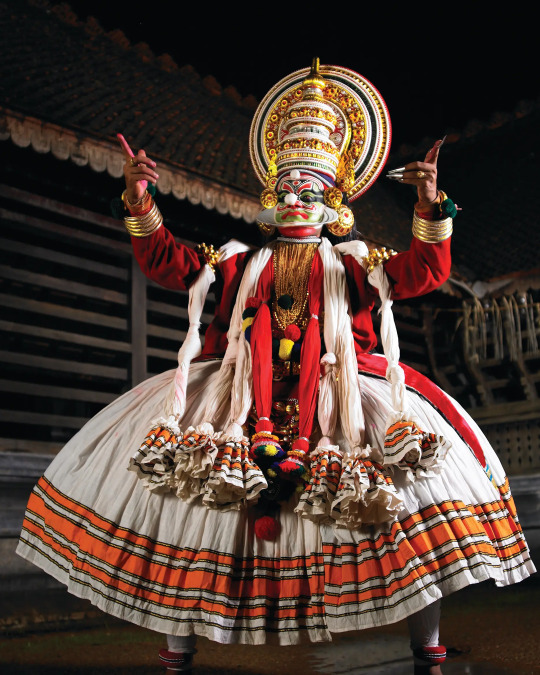
#kathakali#kerala tourism#kerala tour packages#kerala holidays#keralagreenery#kerala tourist places#kerala attractions#kerala performing art forms
0 notes
Link

Among the various traditional dances of this vibrant land, Thiruvathirakali holds a significant place. Rooted in antiquity, this dance form has not only captivated audiences for centuries but has also played a pivotal role in preserving the historical significance and artistic legacy of Kerala.
https://www.indianetzone.com/18/tiruvathira_dance_kerala.htm
1 note
·
View note
Note
what do you think fry's family is like!!! i love him sooo much every time you draw him it's like a gift 🥺🥺🥺
WAUGHGHGHJ these Fry questions make me so happy since he's my Blorbo(TM) <3 Gah I'm itching to talk about him, so ask and you shall deserve!! Also thank you SO much I'm so glad you love my art <33

little sketches related to what I'm about to yap about. ANYWAYS here's wonderwall
So on my old account I used to hc he is Indian-British, whose family hails from Travancore (Kerala nowadays). This was based on what I ASSUMED was canon info since back in January, all Chicken Run wiki articles about him mentioned he's Indian-British. But apparently that's not 100% settled info what his ethnicity is?? And the wikis have been edited since. His VA Nick Mohammed is from a mixed Cypriot/Indo-Trinidadian family though and I spent time reading about Indian-British immigrant history to get Fry's characterization accurate, so imma keep with that hc.
Anyway! I headcanon Marcus is the only child of wealthy businessmen that owned a highly successful trade company. His Vaishya grandparents moved to Britain during the late Victorian era; after all one of the only ways a PoC family could make it back then in Britain was by being filthy rich, and very early on the Fry family had been forced to adopt a "British" way of living in order to be taken seriously by the shitass imperial society. Such as switching to a British surname and avoiding to display too much of their original culture in public. A colonial trauma that still prevails, since Fry's parents christened him with a heavily English name.
I REEEALLY wanna give a try to designing Fry's parents sometime!! But I imagine his parents as sort of a healthier parallel to Melisha's parents; his father is a pristine and calm gentleman with a soothing voice and a love for theatre and literature (a trait that Marcus inherited LMAO) while his mother is more stern, headstrong and very, VERY proud of her status. (but she also has a infectuous smile and laughter and has a bombastic overdramatic streak...something that Fry inherited as well)
They're both native Malayam speakers, and while their family in public strives to keep Keralite culture hidden, they made sure to teach Marcus to speak his native language fluently as well, along with Hindi, Bengali, Tegulu and Tamil. Along with that, they frequently go on family trips to Travancore and enjoy things like inji neer, Kathakali performances (which inspired Fry on his love for theatre <3) and Carnatic music.
Both parents pushed Marcus to study hard and gain multiple academic degrees - it was all out of love and concern, because they wanted Marcus to be able to survive in the cruel world out there without only relying on his money. (Once again, a PoC immigrant family experience that I can identify with as well... even if society nowadays is not nearly as racist as it was back then, unfortunately PoC people are often forced to study waaaay harder than white people in order to make it.) Because they had lived through the years of great depression in the 1930s, and while they managed to survive with most of their wealth intact, they knew that one should not rely only on money for support since anything could happen.
Fry, as a child, was a gifted A+ grade student and a very well-behaved, so his parents called him a little ray of sunshine and a future hope. He yearned to be perfect so his parents would never be disappointed in him. Something that later on contributed MASSIVELY to Fry's gifted child burnout, and how he adopted a sinister, sadistic fascination with mind control and manipulation during his Cambridge years.
Once Marcus came out as trans and genderfluid to his parents, his father was very patient and accepting, but his mother spent several years in denial before finally accepting him. Not directly out of transphobia - but because she was afraid that Marcus would be discriminated, attacked and hurt by people, and that he should focus first on building a career for himself instead of bringing a bad name to the Fry family like this, with an outrageous gender identity. But she soon realized that hiding himself would only hurt her child on the long run. Also - the way Fry managed to fully bribe (cough mind control cough) British officials to switch the gender in his personal info and passport was nothing less than impressive to both of his parents LMFAOOOO and they're very proud
However despite all of this, Fry retains a loving relationship to his parents!! He goes to their mansion every Christmas, and they're also VERY accepting and encouraging to his marriage to Melisha. In fact, his mom was relieved to see Fry had married a very orderly, stern and no-nonsense woman, because Marcus had always been a scatterbrained mess and a reckless money-spender. He made a wonderful scientist, but business-running had never been his thing, so Melisha taking care of all that is like a lottery win to the Fry parents. ESPECIALLY since Melisha came from a poor household - a woman like this, who knows what it's like to live at the rock bottom, surely knows to keep Marcus humble and not let him make flimsy business decisions!! (either way Melisha is still a bit intimidated by Fry's mom, which says a lot considering what kind of a girl Melisha herself is LMFAO)
Pluuuus... the Harsh Expectations(TM) is something that Melisha can relate to </3 It's something that catches her entirely off guard, when she learns this detail about Fry's past. After all, the silly goofy doctor is like an endless ray of sunshine, he's rich and successful. (and we all know what Melisha's mother told her about money bringing happiness...) How could he ever have any worries or feelings of inferiority??
It's a detail that makes (in my hcs) Melisha fall even deeper in love with Fry and become tenfold more protective over him :''') <3 Once she realizes what a horrific burden this goofball is carrying on his back, and yet he still finds the energy every day to stay positive, be optimistic and support Melisha during her hard days.
44 notes
·
View notes
Note
Hi I love your South Asia AU so much, and this is probably a stupid question, that’s why I’m asking on ANON. You mention a few times that Maedhros practices the “ratheeb” and could you mention what it is? I tried to Google, I promise, but there were many different results.
Absolutely not a stupid question, it’s an incredibly niche regional practice in the area my parents are from, and I’ll definitely be explaining it in the chapter in which it’s performed, because it’s very unlikely people outside said region are aware of it.
So ratheeb is short for kuthu ratheeb (ratheeb being a generic word hence your Google results). It’s a self flagellation ritual specific to a tiny subset of Muslims in Northern Kerala, where men go into a trance state and slash at themselves to the rhythm of devotional songs. It’s technically a religious practice but is also performed by non-religious people (for example, Maedhros in this AU) and these days it’s more very painful folk art and performance than anything.
In the story, it’s essentially an allusion towards the Oath, and imo the ritual when performed by non religious people just screams Maedhros to me in general — beating yourself up for a thing you no longer believe in. And in the context of my AU — one look at a ratheeb performance will tell you exactly why the papers called Maedhros what they did.
Might actually help to see it because it’s hard to explain haha, so here’s a YouTube link to a video of the practice (as depicted in a film) — not graphic but TW for blood and obviously self flagellation.
11 notes
·
View notes
Text
Pavitr Prabhakar: The Design
Pavitr Prabhakar my beloved!
I love him. I absolutely love Pavitr and everything about him. And the best thing about him, other than his everything, is his design. So let's get to it!
PART 1: THE MASK
He was so cool and such a total sunshine but the most striking aspect was the immaculate design. Huge upgrade on his old model which was pretty much just a normal spider-suit with a white dhoti, which, not gonna lie, was just disappointing and underwhelming. But they went off on Pavitr's design in the movie and everyone's talking about it so let's also talk about it.
First of all,
LOOK AT MY BOY!!!
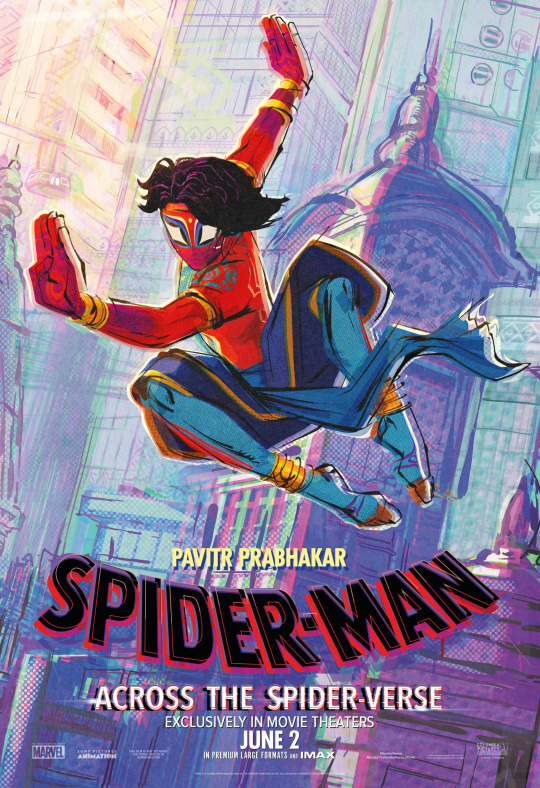
Just look at that design! So cool! So awesome! And so so Desi!!!
Its these desi aspects that I want to shed light on cos I know there are non-Indian fans who didn't catch a lot of the nuances cos they're not familiar enough with Indian culture and even Indian fans who didn't know about some details cos they aren't from the areas the inspiration for these elements were drawn from.
Mainly I hope to help artists and writers with this, so they have more information to create with, as well as the casual fans so they have more info and can immerse themselves better as well as appreciate just how much effort went into making this spectacular movie.
This might be a long post with me just rambling away so braze yourself people.
So lets get into it.
{WARNING: Infodump incoming}
First, lets start with the Mask
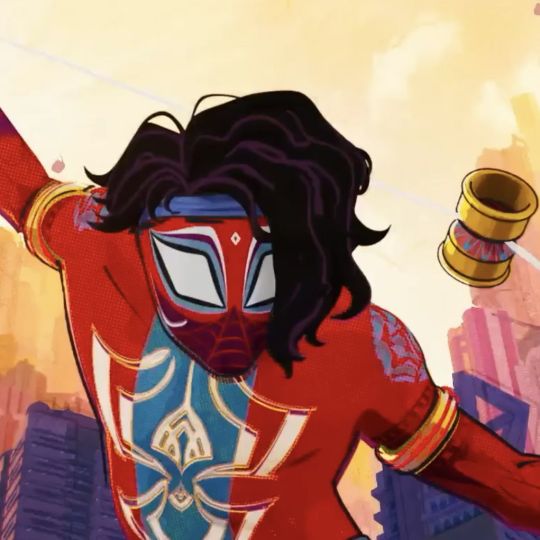
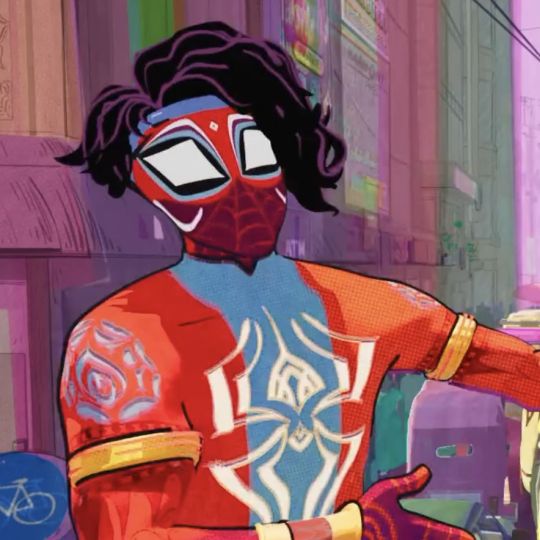
So here we have two different angles of his mask. The most prominent features of his mask are his eyes. There is a multi-layer outline for them in black, blue, red, and white, which of course are the classic spiderman colours but never quite used like this. Usually there is only a single outline in shades of, or adjacent colours of black, red, or white.
(Disclaimer: I'm not a 100% sure of this being actually the inspo behind the eyes. I'm pretty sure though, like 80%. So this has not been confirmed.)
The design for his eyes reminded me of one specific thing:
Koodiyattam, which is a 2000 year old ancient temple artform from the southern Indian state of Kerala. Koodiyattam is not just the only surviving Sanskrit theatre in the world, but it also includes elements of koothu, from the Sangam era, the golden age of Tamizh culture, and thus was declared by UNESCO as a Masterpiece of the Oral and Intangible Heritage of Humanity.
Below is a picture of a Koodiyattam performer.
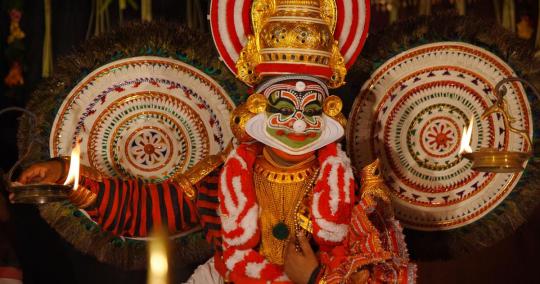
Instantly you'll realize that this is a costume drama, with extensive makeup, and complicated dress, especially with regards to the headgear, and is overall similar to the Beijing opera, not in terms of make or design or performance, but rather in elaborateness of ensemble. Japanese art forms like Noh or Kabuki could also come to mind along with certain Balinese dances.
Here is another photo which will give you a better look.
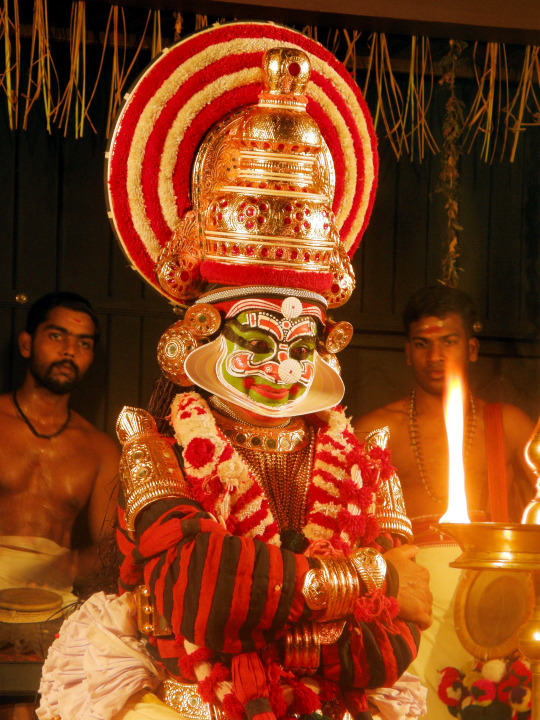
Notice the layered eye makeup in black, red, and white.
Here we have a closeup of a different performer where you can see it even more clearly.

The first time I saw Pavitr's eyes on screen, this is what immediately came to my mind as someone interested in traditional theaters of all kinds. Notice that Koodiyattam extensively uses reds and blacks, along with whites, which is also the colour palette that most spiderpeople choose, which is a cool coincidence. Blue is not that heavily used unlike the others however, but you can see it more in some costumes but generally not in makeup.
If we're talking less of what it reminded me of and more in terms of what the actual inspiration for the eye design probably was, it was most likely Kathakali, Koodiyattam's much younger, more well known, and very popular relative.
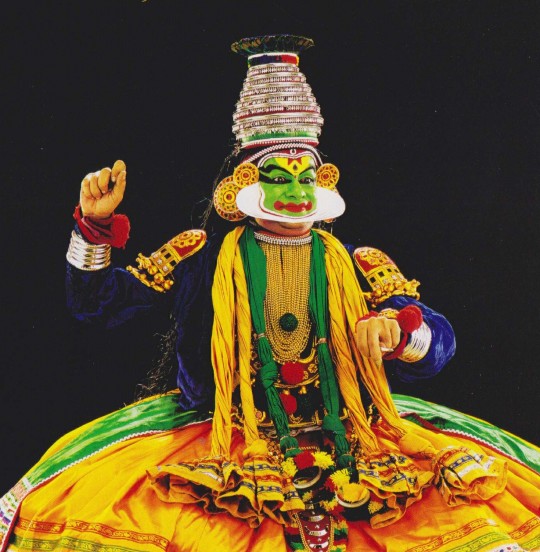
As you can see, Kathakali took its cues for costuming from Koodiyattam. (Actually it took its costuming cues from earlier art forms called Krishnattam, and Ramanattam, but they took it from Koodiyattam so it works.)
Again you can see the layered eye makeup, most prominently in black. (Cool fact, the costume and makeup changes according to the characters being portrayed on stage.)
Below is a picture of a Kathakali character with more elaborate eye makeup.
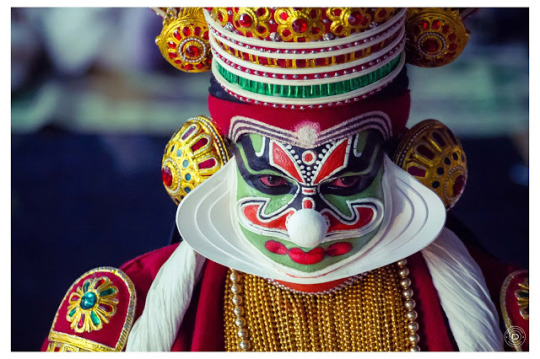
(I know a lot of you might think its the same makeup as Koodiyattam but I promise you its not. Inspired yes, same no.)
Because of the elaborate makeup and costume, expression can be a challenge so the art forms make maximum use of exaggerated body movements, hand signs, dance, lyrics etc. But the crowning element of acting in Koodiyattam and Kathakali are the eye techniques and how much simple eye movements can convey to the audience, which if you think about it, is also the case for spider-people. They're the most expressive superheroes in any medium, but they're fully covered so a lot of their expressiveness, both in comics and animation is conveyed through the shape of the eyes, body language, and speech. Another cool coincidence.
Below is a link to a short video which gives an brief overview of Kathakali and the importance of eyes in its performance.
youtube
This second link is a closeup of the eye movements of a female Kathakali character (women characters are called 'Minukku'). It shows how these highly trained artists can even move their eyes according to music. I have been told this can be uncomfortable to watch for some people so here's a warning for those who find eyeballs discomfiting.
youtube
And finally this one right here is a link to a short video on Koodiyattam.
youtube
{All three of these links are mainly aimed at people who find this sort of stuff interesting and want to check them out so if you're not, you can scroll past it, no big deal!}
(Oh man this is getting way too long and more like me gushing about traditional theatre than spiderman. Sorry about that.)
Now lets get back to our boy Pavitr. The second most noticeable feature of his mask is the curved, white line underneath his eyes, which gives off the impression of tusks. The first two pictures on this post already show the lines quite clearly but I'll attach one more angle.
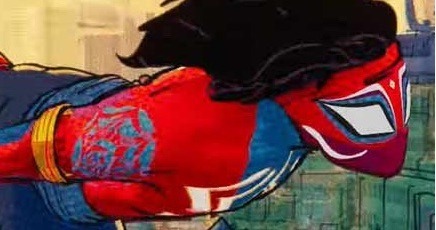
Something that immediately came to mind when I saw them was Theyyam but I wasn't sure until I saw this post.
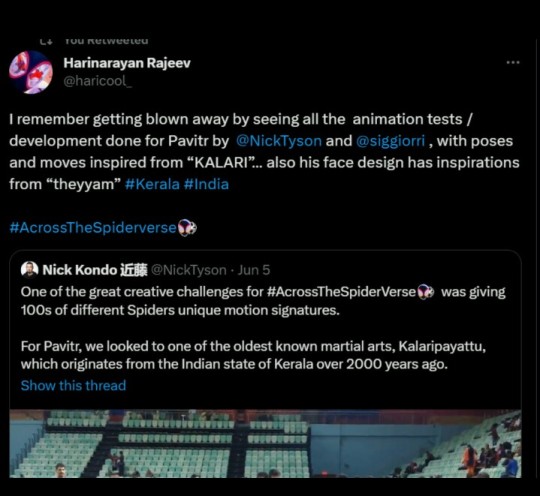
This was the same account that talked about how Pavitr's movements are inspired from Kalaripayattu so I was inclined to trust this. And after this one of the animators did confirm this so I was right on the money.
What exactly is Theyyam?
It is an ancient Hindu folk ritual practiced in northern Kerala, predominantly in the North Malabar region. Its origins can be traced back to the neolithic and chalcolithic eras. And unlike Koodiyattam and Kathakali which are associated with temples and the Koothambalam(temple theatre where temple artforms are performed), Theyyam is performed in the open air in Kaavu, the sacred groves of Kerala. The Theyyam performers become channels and vessels for the gods. Connect this to the 'Great Weaver'/ 'Master Weaver' who gave Pavitr his powers.
(Btw, these sacred groves are also ecological treasure troves and one of the ancient ways of nature preservation and they're really cool so check them out if you can.)
Below are two images of different Theyyams.

[Puliyoor Kali Theyyam]
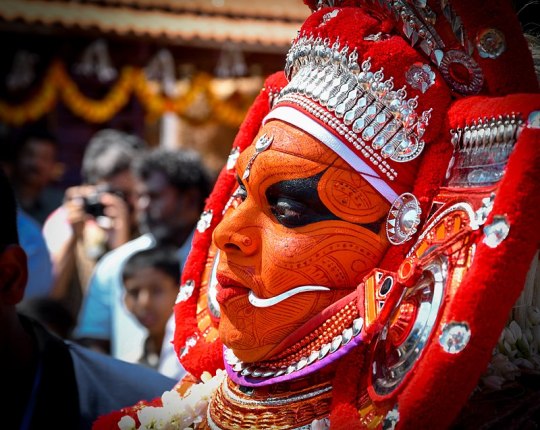
[Porrkali Theyyam]
See that on the cheeks? It resembles Pavitr's design closely right? While Pavitr's are drawn on his mask, these are singular metallic pieces, bound or clutched in the mouth to evoke the imagery and impression of tusks.
Theyyam is not alone in this particular imagery. A variety of folk arts use this, especially animism and folk rituals to show animal physical characteristics, as well as supernatural powers and elements.
For example, below is an image of Thirayttam, a ritual folk practice from the South Malabar region of Kerala. You can see the tusks here too. (Its not that clear, sorry about that.)
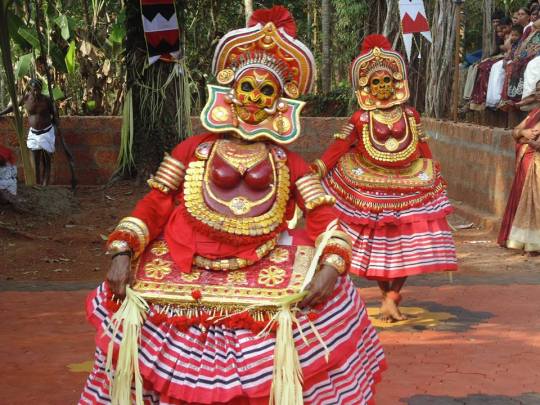
{Reminder: A lot of people think of Theyyam and Thirayattam as the same thing. While there are many similarities, with both being from the Malabar region, they are different practices. Theyyam is also called Tiṟa, and this is the main cause of the confusion but its not Thirayattam.}
Another example is Kalamezhuthu pattu, another religious folk art from Kerala. Mainly associated with the worship of the goddess Badhrakali, it is a sacred floor art done with powder and the result is called a Kalam. Below is a picture of a Kalam.

See those tusks? Yeah.
So they represent divinity, animal characteristics, inhuman powers etc.
[Interesting Info: Drawing Kalams are an integral part of Mudiyettu, a traditional ritual theatre and folk dance drama from Central Kerala. It is inscribed in the Representative List of the Intangible Cultural Heritage of Humanity. So do check it out if you're interested.]
{Oh my god I'm going off topic again. Come back bitch.}
To conclude, those lines are inspired by Theyyam markings, and stand for tusks and fangs, and as a spiderperson, who has the powers of a spider, gifted by some spiritual channel, its really apt that he was given such a design.
Next, lets talk about the lower half of Pavitr's mask.
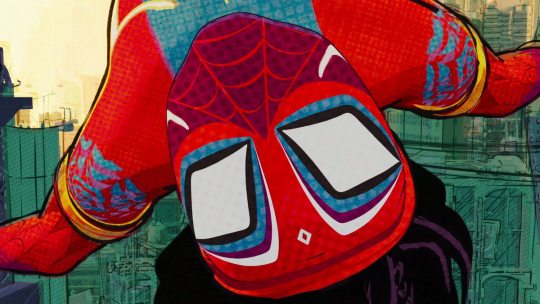
See those delicate red webs underneath the eyes?
This also reminded me of Theyyam. Its overshadowed by the more vibrant aspects of the costume, but a Theyyam's face has these intricate red patterns as well.

(Look at those eyes, reminds you of Pavitr's eye design right?)
And as you can see in this next image, after the headgear is put on, the designs mainly concentrate on the lower half of the face, much like Pavitr's mask.
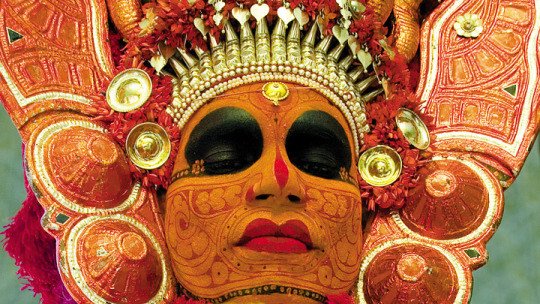
I admit I might be stretching this as web designs on the mask is a spiderman thing in general but I think I'm the pretty much on the dot on this one, and most likely its a combination of both.
[A 100% sure about that tusk thing though :)]
Also sometimes Theyyams would have these metallic eye coverings.

[Muchilot Baghavati Theyyam]
A closer look.

This is just my opinion but those silver eye masks kind of reminded me of the classic Spiderman eyes. Single colour, pupil-less, black outline, no idea how they see out of it etc. This one in particular reminded me of the classic spiderman especially with the eyes outlined in black like that.
Overall, the tusks, plus the thin web design on the mask, and the eyes, the spiderman red colour palette, they all evoked the image of Theyyam for me when I first saw Pavitr on screen.
{There is a very similar art form to Theyyam called Bhootakola in the coastal region of Karnataka, another southern Indian state. Those curious about Theyyam can check out the Kannada movie Kantara which deals with Bhootakola and you'll get an idea about Theyyam as well. The movie is awesome by the way. Watch it if you can.)
(This is getting way too long and image heavy. And I'm also going off tangent too much. Gotta wrap this up!)
Finally lets talk the last aspect of Pavitr's mask. This might actually be the feature that most of the non-Indian audience identified as Indian without anyone pointing it out.
I'm talking about the white, diamond shaped marking on Pavitr's forehead.
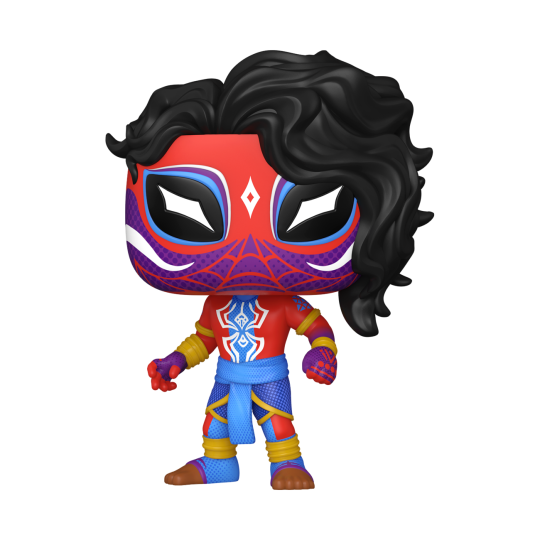
This decorative marking, bindi/pottu/tilaku, might actually be the most recognizable aspect of Indian culture across the world.
If you scroll back to all the previous images I provided, you can see some variation of this in all of them, either drawn on, or as an ornament. While there are some cultural differences in how they're worn, like women in southern India wearing them in all stage of life while their northern counterparts wear them only after marriage(I could be wrong about this, as I've seen children wearing them often, and things could've changed in modern times so please do correct me if I'm wrong), its one of the most common motifs you'll see across the country.
It can be a simple, round mark.
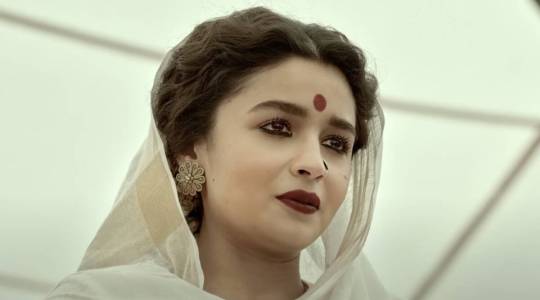
It can be ornamented.
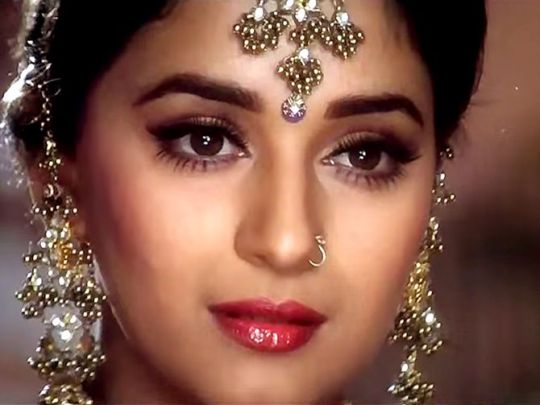
It can be a different shape altogether.
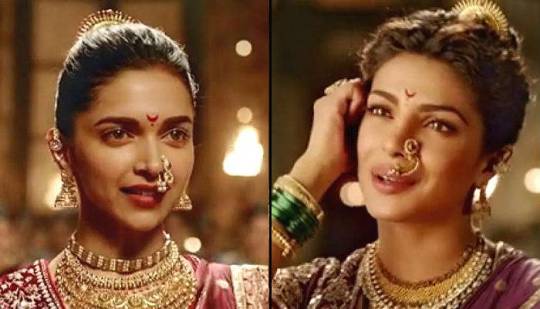
(From the musical sequence 'Pinga' in the Hindi film Bajirao Mastani)
A different colour.
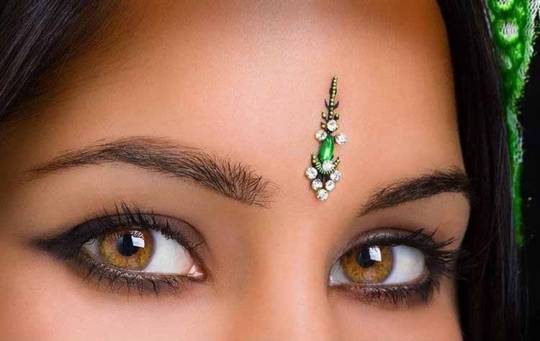
You get the idea.
Men can wear it as well. though styles and decoration maybe different.
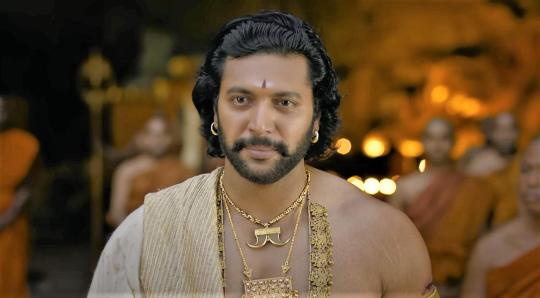
(From the Tamizh film Ponniyin Selvan 1)
A more modern version.
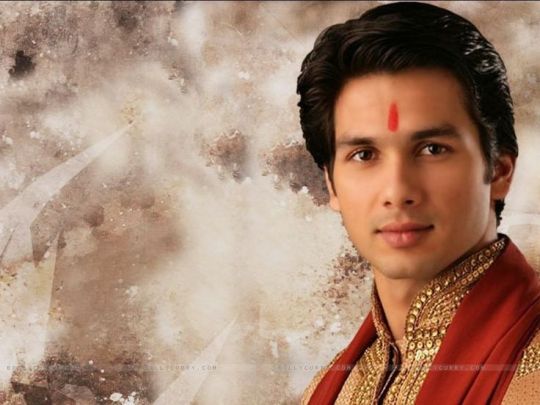
Geography wise, the bindi/pottu/tilak is predominantly seen in India, but its also found in other countries of the Indian subcontinent and neighbouring nations, as well as South-East Asia(as they were both part of the ancient Indosphere and had a past of Hindu Kingdoms. See: Srivijaya(Sriwijaya) empire, Indonesia).
Similar forehead markings were even common in China in the past. Those who have seen wuxia and xianxia dramas and movies definitely have seen them before and know what I'm talking about. (Huadian 花鈿)
Religion wise, its predominantly a Hindu motif, but its also part of Buddhist, Jain, Sikh, as well as several other indigenous religions.
{I've actually seen several Indian Christians and Muslims wear it as well, because its their culture, even if its not their religion.}
EDIT: Gaaaaah! I forgot to include this even though I'd intended to from the beginning.
This is not about the mask but some of the prototype designs for Pavitr so I thought I'll just talk about them a bit here.
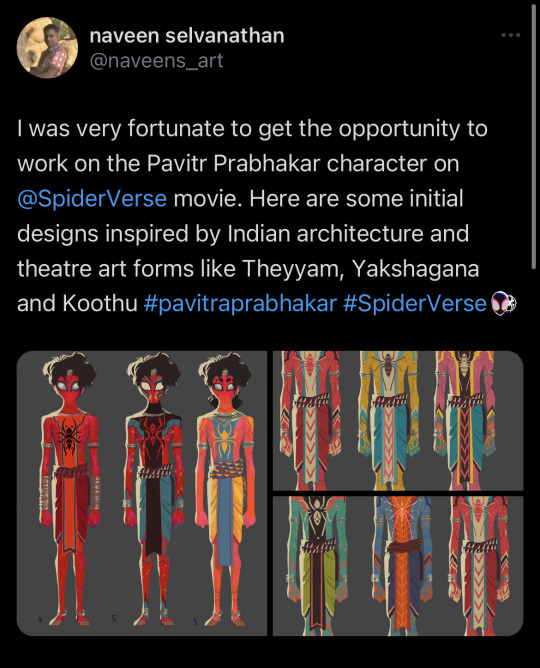
Again I can't believe all the effort that went into making this movie. Just look at those designs. Absolutely stellar and inspired. The colour palette itself is amazing.
Honestly everyone else just has no excuse anymore.
[I'll focus on the theatre aspect like I've been doing and talk about the architecture bit sometime else.]
This one is obviously the Theyyam inspired one.
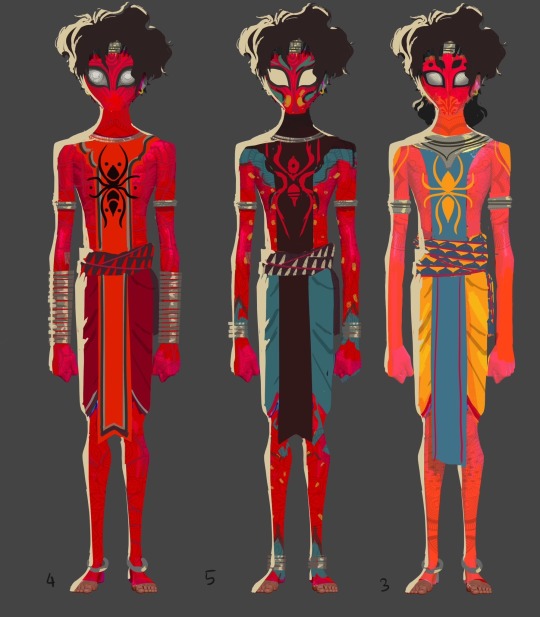
(Look at the eyes of 4 and 3, you can see they're inspired by the silver eye-mask I mentioned before. Also the headband is silver and looks similar to the bands securing a theyyam's headgear in place.)
A lot more Theyyam elements than what made it to the final cut. Especially the jewellery and the sharp-eyed among you must've already noticed the similarity between the necklaces of the design and the necklaces of the theyyams whose images I provided. The bangles and the anklets are also very distinctively Theyyam and they're called Katakam and Chutakam respectively but the final design seems to have made the bangles gold and more bracelet-like, and the anklets more like ankle-cuffs.
(I so badly wish the necklace stayed in but yeah that could've hindered movement.)
Now lets come to the Yakshagana inspired one.
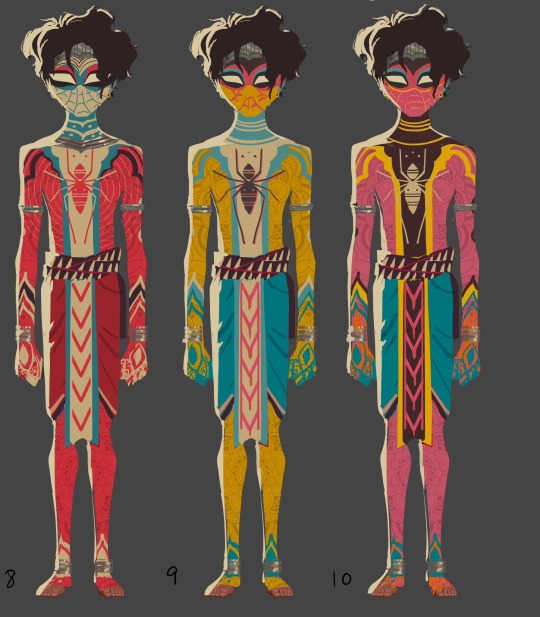
(Notice how the shape of the eyes have changed? And the colour palette took a turn? A lot more gold coming in.)
Yakshagana is a form of traditional theatre originating in modern day Karnataka state of India, and currently practiced in both Karnataka and Kerala. It is primarily an art form from the coastal Karnataka region and the neighbouring Kasargod district of Kerala.
Below is a link to more information on Yakshagana so you can take a look at the costuming and see the influences in the above prototype more clearly.
(I'm not gonna go into detail about all the design choices in the Yakshagana prototype, maybe in another post.)
Now lets come to the final prototype.
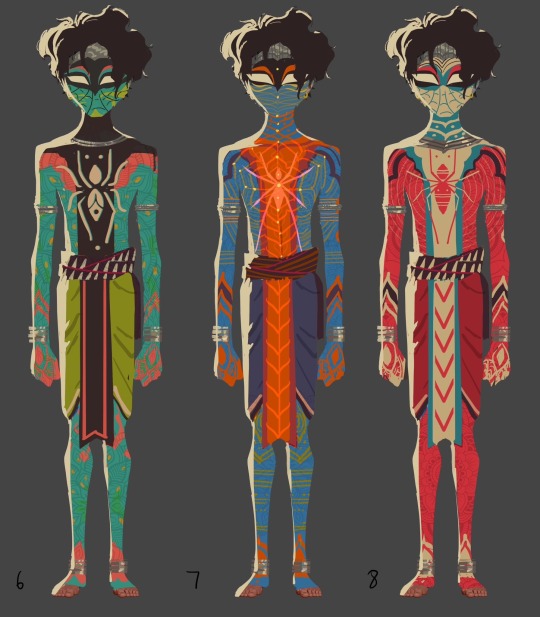
(Again the colour palette has shifted, a lot more greens and blues. I do believe that 8 is koothu and not Yakshagana even though it was included in the image above. I say that because of all the white in the design which is very distinctive of a kind of koothu as far as I'm aware.)
I actually already mentioned koothu once before in this post when I was talking about Koodiyattam in the very beginning. So lets go back to it.
Koothu is a folk theatre art that originated in early Tamizh country(Tamizhakam), and broadly speaking, its of two types, Terrukuttu, and Kattaikkuttu. It reached its peak in the golden age of Tamizh culture, the Sangam era and it mainly depicts scene from the epics. Currently types of Koothu are practiced in modern day Tamil Nadu and Kerala(Kerala was once part of ancient Tamizhakam).
Below is a link that will give you more info and an image of the costume with makeup similar to 6.
And this one is a link to a particular kind of koothu in Kerala known as Chakyar Koothu cos all the white on the make of prototype version 8 reminded me of it. (Also Chakyar Koothu is a form of social satire and criticism, it was basically ancient Stand-up comedy and the Chakyar is supposed to be really witty, which fits Spiderman to a T I gotta say.)
Again I'm not gonna go into further details and nuances of the design as this is a prototype design, maybe some other time. But I have to say that this colour palette does make Pavitr a lot more spideresque or evoke a more primal spider energy cos how it connects the viewer to jungle like and more animalistic environments more than the other designs.
And that's it for the mask and the prototypes everybody! Yay!
Holy shit that was long!
I'm gonna stop here for now cos this is already way too much. Can't believe I thought I'd be able to look through the entirety of Pavitr's design in one post. What was I on?
Seriously what kind of drug?
Anyway I'll be making a part 2 for this, looking through Pavitr's clothes and and movements and all. I say Part 2 but considering what happened with the mask I'm pretty sure it might go up to Part 3 or 4. Here's to hoping I learn some moderation by then lol.
(All the images are from google images and I have taken and have credit for exactly none of them. The verbiage is mine completely though.)
#Pavitr Prabhakar#Spiderman India#Indian spiderman#desi spiderman#spiderman atsv#character design#desi design#the desi-gn get it? I'll show myself out#across the spiderverse#spiderman: Into the Spiderverse#Spiderman: Across the Spiderverse#sony spiderverse#atsv#so much love and effort went into this movie and it shows#it was absolutely magnificent#character design inspiration#Indian culture#traditional theatre#traditional artforms#Theyyam#Koodiyattam#Kathakali#Yakshagana#Koothu#Tamil culture#Tamizh culture#Malayali culture#Kannada culture#tulu culture#tuluva culture
82 notes
·
View notes
Text
In Israel, you’ll find a patchwork of different communities. Most Israeli Jews originate from Europe, North Africa and the Middle East, but some come from other regions, such as India.
According to the Indian Embassy in Tel Aviv, there are about 85,000 Jews of Indian origin in Israel — so Indian Jews make up just 1.2% of Israel’s Jewish population. This small community is divided into four groups: the Bene Israel from Maharashtra, the Cochin Jews from Kerala, the Baghdadi Jews from Kolkata, and the Bnei Menache from Mizoram and Manipur.
Although I grew up in the U.S., my mother’s family is from the Cochin Jewish community in Israel. I wanted to find out more about how this community is preserving our unique Jewish traditions from the South of India.
Many of these traditions are at a risk of dying out. For example, the language of the Cochin Jewish community is called Judeo-Malayalam. Today, this dialect has only a few dozen native speakers left (you can hear it spoken in this video).
According to legend, the first Jews arrived in Cochin during the time of King Solomon. The oldest physical evidence of their presence is a set of engraved copper plates dating from around 379-1000 CE, which were given to community leader Joseph Rabban by the Chera Perumal dynasty ruler of Kerala.
Jewish sailors originally arrived in Kodungallur (Cranganore), an ancient port city known as Shingly by Jews, before shifting to Cochin following a flood in 1341. These Jews became known as the Malabari Jewish community. After the expulsion of Jews from Spain in 1492, a group of Sephardic Jews also came to Cochin, and became known as the Paradesi (Foreign) Jews. The Malabari and Paradesi Jews historically lived separately and maintained their own traditions, although in modern times this division has become less important.
Today, the vast majority of Cochin Jews live in Israel. I spoke with several community members to learn about current projects in Israel to preserve Cochini Jewish culture.
Hadar Nehemya, a jazz musician and performer, runs a food delivery service sharing traditional Cochin Jewish recipes. Hadar learned the art of cooking from her mother, who learned it from her paternal grandmother.
Cooking her dishes from scratch and selling them at markets and for delivery, Hadar’s goal is to introduce Cochini cooking into the mainstream of Israeli culture. “Many Israelis don’t know much about Cochin Jewish culture. Maybe they met a Cochini person in the army,” she said. “But Indian food is popular in Israel, because Israelis love to visit India after they finish their army service.”
Cochin Jewish cuisine is similar to other types of South Indian cuisine, but also has influences from Iberian and Middle Eastern cooking. One example is pastel, pastries with a spicy filling that are similar to empanadas. Other staples include fish and egg curries, chicken stew, black-eyed pea stew, dosa (thin rice pancakes) and dishes cooked with coconut and mango.
Hadar’s favorite dishes to cook are idli and sambar, which are often eaten together. Idli is a type of savory rice cake, while sambar is a spiced lentil stew. Although Hadar says it’s difficult to maintain an Indian food business from an economic perspective, she’s passionate about cooking and enjoys creating homemade dishes with the right balance of spices.
Along with cooking, music is also important in Cochini culture. In most religious Jewish communities, women aren’t permitted to sing in front of men who aren’t their immediate relatives. However, this prohibition was not part of the Cochini tradition.
In the Cochin Jewish community, women have sung in Hebrew and Judeo-Malayalam for centuries. Piyyutim (liturgical poems) were sung in the synagogue or at people’s homes during holidays. Judeo-Malayalam folk songs were sung at weddings and special occasions, and the lyrics of these songs were recorded in notebooks to hand down to future generations. Later, many women also learned Zionist songs in preparation for moving to Israel. I have memories of my own grandmother singing these songs at home.
In recent years, audio recordings have been produced of Cochini songs, including a collection called “Mizmorim” (Psalms) featuring Hadar’s grandmother, Yekara Nehemya. Hadar then created her own version of one of the songs, “Yonati Ziv.”
Today, community leader Tova Aharon-Kastiel has organized a choir which meets once or twice a month at different locations. In the choir, Cochini and non-Cochini women, mostly aged 65-85, sing songs in Hebrew and Judeo-Malayalam. The older generation is eager for the younger generation to get involved, but since most younger Cochin Jews have a mixed background and are assimilated into mainstream Israeli culture, this is sometimes proving a challenge.
Still, many young Cochin Jews are eager to connect with their roots. The community maintains several Facebook groups, including one specifically geared towards the younger generation. The group description reads: “If you are a young Cochini, you surely know (at least partially) the wonderful heritage of our forefathers and mothers… the sad truth is that this heritage is currently on its way to pass from the world.”
Shlomo Gadot is the CEO of Inuitive, a semiconductor company, and is actively involved with Cochini community projects. His nephew, Ori, runs the Facebook group for the younger generation. Shlomo says events are regularly held at the Indian Embassy in Tel Aviv for young Cochinis. “Normally the embassy gives them their office in Tel Aviv, and they invite the young Cochini people to come there and do a trivia contest,” he said. “They do it twice a year, once at Hanukkah and once at Passover.”
According to Shlomo, the embassy also has initiatives to create connections between Indian and Israeli tech companies. “Sometimes they invite people to the ambassador’s house or office to see how they can create connections between Israeli and Indian companies,” he said. “They also have a program to bring young people to India to help them get to know India better.”
Anil Abraham is one of the few Cochin Jews with recent memories of life in India. Born in Jerusalem, his family returned to India when he was 8 years old, and he lived there until age 35 before migrating back to Israel. He says he found growing up Jewish in India difficult, but rewarding. “It was very difficult to move there from Israel and learn Malayalam,” he said. “But it was amazing to be part of the community and enjoy Cochini food prepared from scratch. We used to attend prayers in the Paradesi Synagogue, because right now there are fewer than 20 Jews in Kerala.”
Today, Anil runs tours of Kerala for the Cochin Jewish community and others. “The kids travel with their parents and grandparents to India,” he said. “That’s how our traditions are passed down.”
16 notes
·
View notes
Text
Stronger, Safer, Better: Discover the Best TMT Steel Bars !
As the No.1 TMT steel bars manufacturer, we pride ourselves on producing high-quality TMT bars that adhere to the most stringent industry standards. Our state-of-the-art manufacturing process ensures the production of durable, corrosion-resistant, and highly flexible TMT steel bars, suitable for all types of construction projects. Whether you’re building a residential, commercial, or industrial structure, our TMT bars offer unmatched strength and reliability. Choose us for the best quality and dependable steel reinforcement.

When it comes to selecting the best TMT bars in Palakkad, Kerala, our product range stands out for its unparalleled strength, flexibility, and long-lasting performance. Manufactured using advanced technology, our TMT steel bars ensure superior resistance to seismic forces and corrosion, making them the ideal choice for construction in Kerala's diverse climate. Choose our high-quality TMT bars for your building and infrastructure projects, and experience the difference in performance and durability.
As leading TMT bar manufacturers in Palakkad, Kerala, we specialize in producing high-quality TMT steel bars that offer the perfect balance of strength, durability, and flexibility. Our TMT bars are manufactured using the latest technology, ensuring that they meet international quality standards. We are committed to providing our clients with steel reinforcement solutions that are both cost-effective and reliable. Whether you’re working on residential or large-scale commercial projects, our TMT bars are designed to provide maximum safety and strength.
Best TMT Bar for House Construction
For house construction, the best TMT bars provide the ultimate combination of strength, ductility, and corrosion resistance. Our TMT bars are designed to withstand the stress of building structures in different climatic conditions, ensuring long-lasting durability. With the latest technology in steel manufacturing, we offer TMT bars that offer enhanced safety and structural integrity, making them the perfect choice for residential construction. Trust our high-quality TMT steel bars to build your dream home with strength and security.

As the supplier of the best TMT steel bars in Palakkad, Kerala, we ensure that our products meet the highest quality standards for safety and durability. Manufactured using the latest technology, our TMT bars are highly flexible and resistant to corrosion, making them ideal for use in construction across diverse conditions. Whether you’re involved in residential, commercial, or industrial construction projects, our TMT steel bars will provide the necessary strength and reliability for your building needs.
We are one of the leading TMT steel suppliers in Palakkad, Kerala, offering premium-quality steel products for all types of construction projects. With a focus on excellence, we supply TMT steel bars that are strong, flexible, and durable, meeting the highest standards of quality and performance. Whether you need steel for residential buildings, bridges, or large-scale infrastructure projects, we have the right TMT steel bars for your specific requirements. Count on us for timely delivery and competitive prices.
As one of the top TMT bar manufacturers in Palakkad, Kerala, we take pride in providing our customers with high-performance steel bars that are suitable for all types of construction applications. Our TMT bars are engineered with advanced technology to ensure superior strength, ductility, and corrosion resistance. With a reputation for excellence and a commitment to customer satisfaction, we are the preferred choice for contractors and builders across Kerala. Choose our TMT bars for reliable reinforcement solutions that stand the test of time.
#commercial#interior design#sales#type#manufacturing company#manufacturing#manufacturer#fiber art#tmt steel bars#steel structure#steel manufacturer#steelers#steeldoors#product#wall#artists on tumblr#tmt bars#tmt steel#tmt steels#steelsolutions#steelsupplier#suppliers#services#kerala#palakkad#no. 1#business#development
3 notes
·
View notes
Text
Dear sir..My sincere thanks for Nobel week calling.It is the ill fate of India who could not get some olympic golds for getting some then valid few complete and few incomplete compact disc rsdunpwork till date as for lack of funds and abilities and facilities though politically they loved grabbing and looting in their name party wise which was not appreciable between bureaucrats and scientists.Further..my help to reach world class in chess was not so appreciable for some money had to be shelled and they seemed to grab the entire work money for they were exposed by press media people before us on behalf of which they loved thwarting us and fundamental rights.(Article 23;24 constitution of India).Today too they deliberately destroyed my 50 lakhs instead of allowing me to visit Sweden via delhi.Now as things have been denied india has to face defeat Anyway my sincere thanks as kerala bows out and india crashes out as forecasted from 20 or 22 yr attempts from the research labs to which our awards won sci comms rsdunpwork entered then valid from nobelorg.Rest is to know how well 20-22 yrs after foreign univs and their research labs are worth for drugs medicines vaccines instruments new world records and if the answer remains the same things are destined for the future as from our ongoing reviews..thanks..if revalidated. ..yours sincerely,DR/Advocate etc R S D Unnithan and DR/Advocate etc R S U Unnithan legal chambers etc kottarakara kollam kerala india [email protected] [email protected] [email protected] ref it was a hard fastidious techno work to win me everything as then valid..nowadays who will dare to perform from 2002-24 or 1984-2024..my thanks once more from academics bnr bt zmr sports phy med to kings queens Nobel committee etc ..do find my latest card specifying exservice status and as blogged etc as various publications online.Wishing you all the best for it was a trust with destiny and encounter with god's and goddesses.Beware..arts beggars can't trick to a kill by cultures including scientists.dated:01-04-13 oct 2024-99:8099ad ref some letters send to vcs and Nobel org with latest resume for treatment of my brother's leg

5 notes
·
View notes
Text
Top Luxury Resorts In Ernakulam
Barons Villa stands as a paragon among the top luxury resorts in Ernakulam, offering an unparalleled blend of opulence, comfort, and natural beauty. Renowned for its exquisite design, exceptional service, and commitment to sustainability, Barons Villa provides guests with an unforgettable experience that perfectly harmonizes luxury and nature.
Exquisite Accommodations
The accommodations at Barons Villa redefine luxury. Each room, suite, and villa is meticulously designed to provide the utmost comfort and elegance. The interiors feature a blend of modern aesthetics and traditional elements, using high-quality materials like polished wood, marble, and local art. Large windows and private balconies offer stunning views of the surrounding landscapes, allowing guests to immerse themselves in the beauty of Ernakulam without leaving their rooms. State-of-the-art amenities, plush furnishings, and personalized services ensure that every stay is a memorable one.
World-Class Amenities
Barons Villa offers a range of world-class amenities designed to cater to the diverse needs of its guests. The resort boasts multiple swimming pools, including an infinity pool with breathtaking views of the natural surroundings. A fully equipped fitness center, complete with modern exercise equipment and professional trainers, allows guests to maintain their fitness regimes. For those seeking relaxation, the spa offers a variety of treatments and therapies using organic and locally sourced products. The wellness center also features yoga and meditation sessions held in serene garden settings.
Culinary Excellence
Dining at Barons Villa is a gastronomic journey that reflects the rich culinary heritage of Kerala. The resort’s restaurants offer a diverse array of dishes, from traditional Kerala cuisine to international gourmet delights. Emphasizing fresh, local ingredients, the culinary team crafts menus that celebrate the region’s flavors and traditions. Guests can dine in elegant indoor settings or choose al fresco options with views of the lush landscape. The resort also offers private dining experiences for special occasions, ensuring a personalized and intimate dining experience.
Scenic Beauty and Outdoor Activities
The scenic beauty surrounding Barons Villa is one of its most compelling features. Nestled amidst verdant hills, forests, and water bodies, the resort provides a tranquil escape from the hustle and bustle of city life. Guests can explore the natural surroundings through a variety of outdoor activities. Guided nature walks and hiking trails offer opportunities to discover the local flora and fauna, while water-based activities like kayaking and boating provide a unique perspective of the area’s natural beauty. For adventure enthusiasts, the resort organizes excursions and safaris that delve into the heart of Ernakulam’s wilderness.
Sustainable Luxury
Barons Villa is committed to sustainability, implementing eco-friendly practices across its operations. The resort employs renewable energy sources, such as solar panels, to reduce its carbon footprint. Water conservation measures, including rainwater harvesting and wastewater recycling, are integral to its operations. Waste management practices focus on reduction, reuse, and recycling, minimizing the resort’s environmental impact. These initiatives ensure that Barons Villa not only provides luxury but also promotes environmental stewardship, preserving the natural beauty of Ernakulam for future generations.
Cultural Immersion
Ernakulam is rich in culture and history, and Barons Villa offers guests the chance to immerse themselves in the local heritage. The resort organizes cultural tours and experiences, including visits to nearby historical sites, traditional dance performances, and culinary workshops. These activities provide guests with a deeper understanding of the local culture and traditions, enriching their stay at Barons Villa.
Personalized Services
At Barons Villa, personalized service is a hallmark. The dedicated staff is trained to anticipate and cater to the individual needs of each guest, ensuring a seamless and luxurious experience. From personalized welcome amenities to bespoke itineraries, every detail is carefully curated to exceed guest expectations. The concierge service is available around the clock, ready to assist with any requests, be it arranging transportation, booking excursions, or providing local recommendations.
Conclusion
Barons Villa epitomizes the essence of luxury and hospitality, making it one of the top luxury resorts in Ernakulam. Its exceptional accommodations, world-class amenities, and stunning natural surroundings provide an idyllic retreat for discerning travelers. Whether seeking relaxation, adventure, or cultural immersion, guests at Barons Villa can indulge in a truly unique and memorable experience. By combining luxury with sustainability and personalized service, Barons Villa sets a new standard for luxury resorts in Ernakulam, offering an unparalleled escape into the heart of Kerala's natural beauty and cultural richness.
3 notes
·
View notes
Text
Evolution of Indian Classical Music: A Journey through the Rich Tapestry of Indian Traditional Art Forms
ART, INDIAN CLASSICAL ARTS, INDIAN TRADITIONAL ART FORMS
0 notes
Text
Unleashing Digital Success: Discover Digicult, the Premier Digital Marketing Agency in Kerala
To grow and succeed in the new digital age, organisations have to accept the potential of internet platforms. The top digital marketing company in Kerala, Digicult, steps in to help with that. Digicult is here to improve your brand's online presence and produce noticeable results with a heavy focus on social media marketing, search engine marketing, and branding. Let's explore further why Digicult is the go-to company for digital marketing requirements.
The Power of Digicult's Expertise
A digital marketing company known as Digicult, with its main office in the growing town of Kochi, has a wealth of experience and knowledge in assisting companies to succeed online. Digicult maintains a team of seasoned experts at the forefront of digital marketing trends to keep your company one step ahead of the competition.
Unleashing the Potential of Social Media
Digicult is skilled in using the power of social media platforms, which have become an essential part of our everyday lives, to increase the visibility of your brand. Digicult assists you in engaging with your target audience, fostering brand loyalty, and generating relevant conversations about your goods or services through effective social media marketing initiatives.
The Art of Search Engine Marketing
Being found online is essential in the modern digital world. Digicult uses both pay-per-click (PPC) and search engine optimisation (SEO) advertising tactics as part of their all-encompassing strategy to search engine marketing. Digicult makes sure that your brand ranks higher in search engine results and sends quality traffic to your digital assets by optimising your website and performing focused PPC ads.
Crafting Memorable Brand Experiences
Your brand is the heart of your company, and Digicult is aware of the need of forging a unique brand identity. Digicult assists you in creating a powerful brand that connects with your target audience, promotes loyalty, and identifies you from rivals through careful research, imaginative storytelling, and appealing images.
Unlocking Digital Success with Digicult
Working together with a respected digital marketing agency is essential as organisations travels the digital world. The leading digital marketing company in Kerala, Digicult, has a lot of experience in branding, search engine marketing, and social media marketing. Digicult is prepared to realise the full potential of your business in the digital age thanks to a committed team and a dedication to achieving measurable results. Get in touch with Digicult right away to start your transformational road to digital success.
5 notes
·
View notes
Text

"Cinema is the love of my life."
Have you ever experienced the rush of emotions, the thrill of storytelling, and the magic of visual artistry all rolled into one? If you resonate with this sentiment, you're in the right place! Welcome to Cinephile's Corner, a virtual haven dedicated to our undying love for the silver screen.
In this corner of the internet, we gather to celebrate the mesmerizing world of cinema—a universe that has captured our hearts and minds. From black and white classics to cutting-edge masterpieces, we embark on a journey through time, exploring the works of visionary filmmakers who have left an indelible mark on the art of storytelling.
As we venture forth, we encounter an array of cinematic geniuses, each with their unique style and narrative flair. One cannot speak of cinematic brilliance without mentioning the legendary Martin Scorsese, whose films have forever redefined American cinema. From "Taxi Driver" to "Goodfellas" and beyond, Scorsese's storytelling prowess is nothing short of awe-inspiring.
We delve deeper into the world of art cinema with Andrei Tarkovsky, the Russian auteur whose films are known for their profound philosophical themes and stunning visual poetry. Prepare to be entranced by the ethereal beauty of "Mirror" and the enigmatic journey of "Stalker."
Stanley Kubrick, a master of his craft, shall forever hold a place of reverence in our cinephilic hearts. His meticulous attention to detail and audacious storytelling gave us cinematic treasures like "2001: A Space Odyssey," "A Clockwork Orange," and "The Shining."
And how can we forget Akira Kurosawa, the Japanese maestro whose samurai epics and humanist tales continue to inspire filmmakers worldwide? "Seven Samurai," "Rashomon," and "Yojimbo" are just a few of the many gems he bestowed upon us.
Our love for cinema is not confined to the West; we also cherish the works of revered directors from different regions. In the Indian landscape, we find ourselves drawn to the films of Mahendran and Bharathiraja, who pioneered a new wave of Tamil cinema with their thought-provoking narratives.
Venturing southward to the lush landscapes of Kerala, we lose ourselves in the profound storytelling of Adoor Gopalakrishnan—a master of subtlety and social commentary in Malayalam cinema.
And of course, no homage to world cinema would be complete without paying respects to the maestro of Bengali cinema, Satyajit Ray. His iconic "Apu Trilogy" remains an unparalleled work of art that continues to resonate with cinephiles across the globe.
As we traverse this cinematic landscape, we'll also explore the groundbreaking works of Eric Rohmer and Godard, whose contributions to the French New Wave have redefined cinema's language.
At Cinephile's Corner, we invite you to immerse yourself in the enchanting world of cinema, where every frame is a brushstroke of emotion, every dialogue a symphony of words, and every performance a reflection of the human spirit.
Join us on this thrilling ride of cine-adventure, as we celebrate the past, present, and future of cinema. From passionate discussions and in-depth analyses to reviews and recommendations, this blog is a homage to the love that unites us all—our love for cinema.
So grab your popcorn, dim the lights, and let's embark on this cinematic odyssey together!
Lights, camera, action! Welcome to Cinephile's Corner!
2 notes
·
View notes
Text
Diya & Vilakku (oil lamps of India) with Cross
A diya is an oil lamp common in India and Nepal. It may be made of clay or brass. It usually has a cotton wick dipped in ghee (clarified butter) or other oil. It is often used in Hindu, Sikh, Jain and Zoroastrian religious festivals. Some Christians have created and used diyas for decades as well.
“Jesus is the Light of the World.”
Some old and new ones with crosses are for sale on eBay and Etsy, and featured in this blog post.
+++
A brass diya with a cross and ram's head - presumably representing the ''sacrificial ram caught in the thicket.' It's 4.5" long.

===

===
See my earlier blog post on another antique Christian diya with a cross at https://globalworship.tumblr.com/post/181271897205/antique-diya-oil-lamp-of-india-with-cross
See more antique Christian diyas with crosses at the bottom of this blog post.
+++
Villaku means "lamp" in the Malayalam and Tamil languages. Nilam means "floor." Nilavilakku is a traditional floor lamp used commonly in Kerala as well as in Tamil Nadu (called Kuthuvillakku)
Nilavilakku is usually made of bronze or brass. Usually cotton wicks doused in oil or ghee are used for lighting the lamp.
With the reach of Christianity in Kerala, Saint Thomas Christians (or Syrian Christians) also started keeping Nilavilakku in their churches and homes. Traditionally, the nilavilakku is lighted and kept at the main front entrance of a home. Syrian Christian art forms like Margamkali (a dance about Thomas the Apostle) and Parichamuttukali (an Indian martial-arts dance) are performed around nilavilakku. https://en.wikipedia.org/wiki/Nilavilakku
2. This one is 11" tall.

+++
3. This one is 44" tall, in 2 parts:

+++
4. This one, which I own, is 12" tall:

+++
5. This brass one with an ornate 'sleeba' (cross) stands 6 feet tall.

+++
6. This one of bronze is about 21" tall:

+++
The people living in darkness have seen a great light; on those living in the land of the shadow of death a light has dawned. (Matthew 4:16)
The light shines in the darkness and the darkness has not overcome it. (John 1:5).
God is light, in him there is no darkness at all. (1 John 1:5)
The Lord is my light and my salvation - whom shall i fear? (Psalm 27:1)
+++
More antique diya with crosses, currently listed for sale on eBay:

+++
This one is dated to 1940:

+++
This undated diya has a human figure on it, but I can't identity it.

+++
3 notes
·
View notes
Text
THEKKADY
Thekkady, also known as Periyar, is a popular tourist destination located in the Idukki district of Kerala, India. It is renowned for its abundant natural beauty, wildlife, and spice plantations. Here's what you need to know about Thekkady:
Periyar National Park: Thekkady is home to the famous Periyar National Park, a protected area known for its rich biodiversity. The park is centered around Periyar Lake and is known for its population of elephants, tigers, gaurs (Indian bison), deer, and a variety of bird species. Boat safaris and guided walks are popular ways to explore the park and observe wildlife in their natural habitat.
Spice Plantations: Thekkady is known for its aromatic spice plantations. The region's hilly terrain and favorable climate make it an ideal location for growing spices like cardamom, pepper, cinnamon, and cloves. Visitors can take guided tours of the plantations, learn about the cultivation and processing of spices, and even purchase high-quality spices to take home.
Boating on Periyar Lake: Periyar Lake, located within the national park, is a serene water body surrounded by dense forests. Boating on the lake is a popular activity, allowing visitors to enjoy the scenic beauty and spot wildlife along the shores. The boat cruises offer opportunities for birdwatching and provide a unique perspective of the park.
Kathakali and Kalaripayattu: Thekkady is known for its vibrant performing arts scene. Traditional art forms like Kathakali, a classical dance-drama, and Kalaripayattu, a martial art form, are regularly performed in Thekkady. Watching these captivating performances is a must-do cultural experience for visitors.
Nature Walks and Trekking: Thekkady offers several nature trails and trekking routes that take you through lush forests, spice plantations, and picturesque landscapes. Guided nature walks and trekking expeditions allow you to explore the region's natural beauty, spot wildlife, and enjoy panoramic views of the surroundings.
Ayurvedic Spa and Wellness: Thekkady is also known for its Ayurvedic wellness centers and spas. Visitors can indulge in rejuvenating Ayurvedic treatments, massages, and therapies that promote relaxation, healing, and overall well-being.
Bamboo Rafting and Adventure Activities: Thekkady offers thrilling adventure activities like bamboo rafting, where you can paddle through the calm backwaters of Periyar Lake, surrounded by pristine forests. Other adventure activities in the area include trekking, jeep safaris, rock climbing, and rappelling.
Local Cuisine: Thekkady offers a variety of dining options where you can savor the flavors of Kerala cuisine. From traditional Kerala meals served on banana leaves to spicy seafood delicacies, the local cuisine is sure to tantalize your taste buds.
Thekkady is a nature lover's paradise with its wildlife, lush landscapes, spice plantations, and cultural richness. Whether you seek adventure, wildlife encounters, cultural experiences, or a tranquil retreat, Thekkady has something to offer every visitor.
#thekkady#kumily#periyar tiger reserve#kerala tourism#kerala tourist places#natuerlover#natuerphotography
3 notes
·
View notes
Text
Top 5 Road Trip Destinations for Indian Bikers

Watching scenic landscapes and juggling between the mountains, travelling has always been an otherworldly feeling. And imagine experiencing the heavenly beauty of India with your most treasured companion. Yes, we mean your everyday bike. We have come a long way, from having family trips on cars and buses to solo adventures on a two-wheeler.
Today, bikers enjoy a thrilling tour of the deepest valleys, forests, desserts, and many other exciting landscapes. Apart from giving a wholesome experience, it allows one to get closer to nature and explore the corners of the country. Going on a bike ride helps bikers explore the different cultures, food, traditional art forms, and the individuality of the people residing there. So, if you are looking for one such memorable road trip to make the best of your bike, this blog will list some top destinations you can travel on your bike. Get ready for a breathtaking motorcycle tour in India.
Vroom through the Amazing Destinations in India If you have just bought a new bike for yourself, allow it a sightseeing ride. Plus, unleash your passion for biking and exploring. We have compiled below a list of routes and places you can discover on your bike in India.
Kerala Plan an unforgettable motorbike ride among the impeccable greenery, lighthouses, and pristine beaches of Kerala. The bike trip to Kerala will turn out to be one of your best, with its never-ending landscapes and numerous routes. Moreover, to make the best of the opportunity and experience uninterrupted rides on lengthy routes, ensure taking a reliable bike. An advanced and digitally packed adventure or superbike would enhance your journey on the two-wheeler. For instance, BMW M 1000 R has a significant speed of 314 km/h and a powerful engine and chassis, designed for absolute performance. Also, do not forget to savour the traditional cuisines of Kerala on your ride.
Read More at (Original Source):globalblogzone.com
0 notes